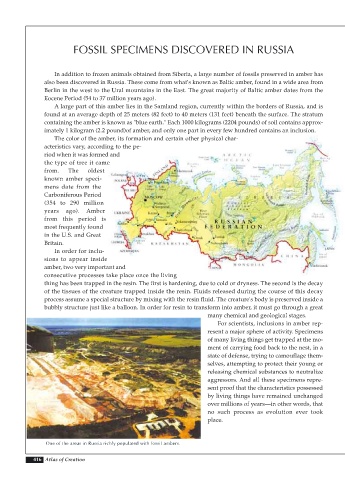Page 418 - Atlas of Creation Volume 1
P. 418
FOSSIL SPECIMENS DISCOVERED IN RUSSIA
In addition to frozen animals obtained from Siberia, a large number of fossils preserved in amber has
also been discovered in Russia. These come from what's known as Baltic amber, found in a wide area from
Berlin in the west to the Ural mountains in the East. The great majority of Baltic amber dates from the
Eocene Period (54 to 37 million years ago).
A large part of this amber lies in the Samland region, currently within the borders of Russia, and is
found at an average depth of 25 meters (82 feet) to 40 meters (131 feet) beneath the surface. The stratum
containing the amber is known as "blue earth." Each 1000 kilograms (2204 pounds) of soil contains approx-
imately 1 kilogram (2.2 pound)of amber, and only one part in every few hundred contains an inclusion.
The color of the amber, its formation and certain other physical char-
acteristics vary, according to the pe-
riod when it was formed and
the type of tree it came
from. The oldest
known amber speci-
mens date from the
Carboniferous Period
(354 to 290 million
years ago). Amber
from this period is
most frequently found
in the U.S. and Great
Britain.
In order for inclu-
sions to appear inside
amber, two very important and
consecutive processes take place once the living
thing has been trapped in the resin. The first is hardening, due to cold or dryness. The second is the decay
of the tissues of the creature trapped inside the resin. Fluids released during the course of this decay
process assume a special structure by mixing with the resin fluid. The creature's body is preserved inside a
bubbly structure just like a balloon. In order for resin to transform into amber, it must go through a great
many chemical and geological stages.
For scientists, inclusions in amber rep-
resent a major sphere of activity. Specimens
of many living things get trapped at the mo-
ment of carrying food back to the nest, in a
state of defense, trying to camouflage them-
selves, attempting to protect their young or
releasing chemical substances to neutralize
aggressors. And all these specimens repre-
sent proof that the characteristics possessed
by living things have remained unchanged
over millions of years—in other words, that
no such process as evolution ever took
place.
One of the areas in Russia richly populated with fossil ambers.
416 Atlas of Creation

